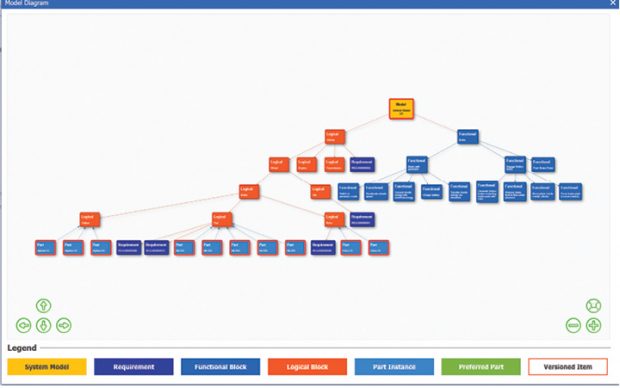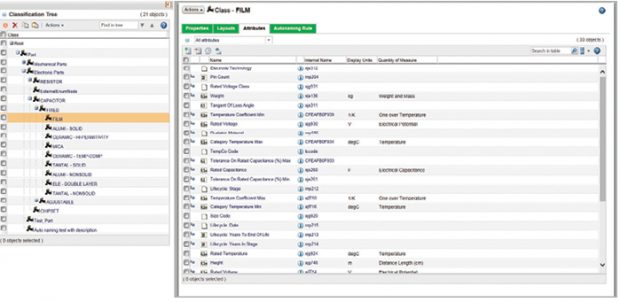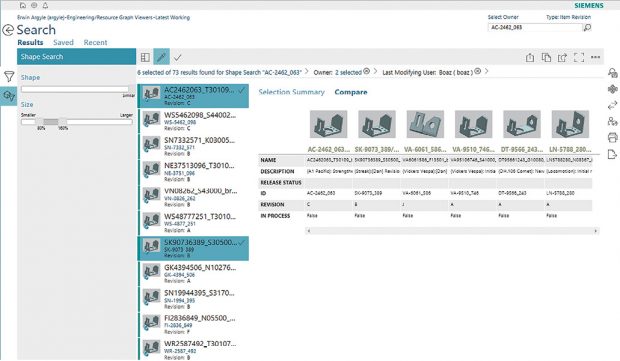
Aras Innovator can directly import/export SysML models and replicate their structure inside the PLM platform, promoting reuse at a systems level. Image courtesy of Aras.
August 1, 2017
Inventing the wheel is one thing, but reinventing it time after time is a development no-no, especially in the wake of mounting product complexity and the need to push innovative products to market faster at reduced costs.
Although model storage and reuse has been an ongoing challenge for design teams, the scope of content engineers hope to reuse has been greatly expanded as software and electronics continue to edge out mechanical components as a dominant part of a product’s bill of materials. CAD and PLM (product lifecycle management) platforms have been steadily enhanced with new search and classification capabilities to help design engineers readily zero in on existing 3D models of parts and assemblies that have relevance to their project, as opposed to having to recreate components from scratch for each new design.
Parts reuse practices have significant ramifications beyond simply reducing costs associated with engineering and design work, experts say. The expenses associated with sourcing, inventorying, tracking and servicing parts increase exponentially with the number of parts and models being managed, so minimizing new parts creation can deliver significant savings for most development organizations over time, according to Dr. Michael Grieves, research professor at Florida Institute of Technology and author of “PLM: Driving the Next-Generation of Lean Thinking.”
 Aras Innovator can directly import/export SysML models and replicate their structure inside the PLM platform, promoting reuse at a systems level. Image courtesy of Aras.
Aras Innovator can directly import/export SysML models and replicate their structure inside the PLM platform, promoting reuse at a systems level. Image courtesy of Aras.Market research firm Aberdeen estimates that between 30% and 40% of a manufacturer’s parts are duplicates, but the engineering costs of those duplicates are just the tip of the iceberg when it comes to controlling costs. Specifically, Aberdeen projects the annual carrying cost of producing a new part number runs between $4,500 and $23,000 for every item when you account for sourcing, transaction and inventory costs.
“There’s still a lot to be said for reuse of geometric models and CAD design, and there is technology evolving to help with that,” notes Bill Lewis, director of product marketing for Teamcenter at Siemens PLM Software.
At the same time, however, Lewis says the concept of reuse is evolving to coincide with the changing makeup of products. “Reuse is evolving into new frontiers—it’s not just about reusing geometry, but a more complex problem now,” he says. “Products these days are rarely just geometric, but include electronics and software, and the concept of reuse has to keep pace with that in order to remain valuable.”
 Windchill’s PartsLink Classification and Reuse capabilities help users locate and reuse parts by comparing functional, physical, supply chain and environmental characteristics. Image courtesy of PTC.
Windchill’s PartsLink Classification and Reuse capabilities help users locate and reuse parts by comparing functional, physical, supply chain and environmental characteristics. Image courtesy of PTC.Classification and Search
Even on the CAD front, the concept of model reuse has changed significantly over the years with CAD and PLM vendors doing their part to enhance search capabilities with consumer-like features to make tagging and finding parts and 3D models easier than in the past. Historically, CAD users’ only hope to facilitate reuse was to manually search for specific names of files on a hard drive—an approach that improved with the introduction of product data management (PDM) and support for metadata, which allows engineers to search on other parameters like date created or assembly name to locate a part for potential reuse.
Siemens’ NX CAD platform, for example, has a reuse library that integrates with Teamcenter, allowing designers to designate specific parts as reusable so others can readily take advantage of them in new designs. In addition, Teamcenter’s classification capabilities enable engineers to define specific attributes about parts and assemblies as they are cataloged into the PLM system. This helps facilitate search and retrieval functionality, especially for engineering teams dealing with increasingly large databases of parts and assemblies, Lewis explains.
SOLIDWORKS, as part of Dassault Systèmes’ 3DEXPERIENCE platform, also benefits from metadata classification schemas to promote parts reuse, says Milos Zupanski, director of product portfolio management. In addition, EXALEAD OnePart, also a member of Dassault Systèmes’ platform, classifies parts based on shape similarity and semantic criteria, ensuring that comparable parts are associated together in families, giving engineers even greater flexibility in evaluating and choosing between parts for reuse, Zupanski says.
 Siemens’ Geolus combines shape and attributes as search criteria, allowing users to control the granularity of the geometry search via sliders. Image courtesy of Siemens PLM Software.
Siemens’ Geolus combines shape and attributes as search criteria, allowing users to control the granularity of the geometry search via sliders. Image courtesy of Siemens PLM Software.Say, for example, you are looking for a flange with four holes. The OnePart capability lets design teams search not just using the word flange, but with descriptions of specific shapes to find the perfect match. “We compute a shape signature based on the geometry and try to find (the) closest match,” explains Shyam Venugopal, Dassault Systèmes product portfolio manager. “In this way, inside a giant database of similar looking screws, you can find what’s most appropriate for your project.” In the end, it’s the combination of the metadata classification and shape search that makes SOLIDWORKS’ parts reuse story so compelling, he claims.
For smaller companies that might not have access to PDM or PLM functionality or the broader 3DEXPERIENCE platform, Dassault Systèmes also offers 3D Content Central, an online database of 3D part models. Dassault Systèmes encourage suppliers and other partners to post certified parts and assemblies to the site, and there are also user-contributed 2D and 3D models—all available for engineering teams to leverage for reuse as part of new designs.
PTC also has poured significant energy into evolving its search capabilities for its Windchill PLM platform, according to Francois Lamy, vice president of PLM Solutions. In addition to classification and metadata capabilities that allow users to search for parts by supplier, compliance rule and other attributes, PTC has added capabilities that mirror consumer platforms like Amazon.com to make it easier to find things without having to build complex search criteria, Lamy says. Let’s say, for example, that an engineer was looking for a pump to reuse for a design. He could filter pump part results by facets like size, power source or even brand just as any consumer might when shopping for an item on Amazon. “Instead of spending time to build a query, you just type in ‘find a pump’ and the system will provide characteristics that can be used to filter results so you don’t need to be an expert,” he explains.
Systems Modeling Kicks Reuse up a Notch
In addition to the work being done on the classification and search fronts, companies like PTC, Aras and Siemens are starting to push the boundaries of reuse even further, introducing capabilities that address the problem at a systems level to accommodate today’s multidisciplinary products. For PTC, which is aggressively steering toward the world of smart connected products, the internet of things (IoT) is a huge catalyst for evolving processes and practices to address reuse at a systems level.
“Products are becoming part of a larger system, and there is a drive to integrate across domains,” says Mark Taber, PTC’s vice president of marketing and go-to-market. “In the systems modeling world, you want to have a set of test cases, validations and processes that might cover one aspect of autonomous driving, for example. Through reuse, you can use that same process to verify another aspect of autonomous driving and modify it from there.” Asset-based modeling and variability modeling on a systems level is addressed with PTC’s Integrity Modeler, part of its application lifecycle management (ALM) portfolio.
Aras is also actively steering its Innovator PLM platform toward a model-based systems engineering (MBSE) approach, which addresses reuse at a systems level, says Doug MacDonald, the company’s product marketing director. To this end, the company has come up with a reference architecture that integrates MBSE and PLM, allowing SysML (systems modeling language) models to be imported/exported and their structures replicated inside the Innovator PLM platform.
By doing so, organizations benefit from the stricter configuration and release controls supported by PLM on SysML models, which encourages reuse of previously architected subsystems, extends the digital thread and addresses a gap in existing MBSE offerings, MacDonald says. In addition, there is traceability of individual system models in an overall “system-of-systems,” and forward and backward integration aimed at streamlining the flow of product information across the various stakeholders and functional engineering teams.
Initially, Aras is providing this PLM/MBSE integration for No Magic’s Cameo offering, but the company is evaluating and working on integrations between Innovator and other MBSE tools, MacDonald adds. “The same value and principles of reuse still apply, but you want to be able to reuse a system containing mechanical parts, electronics and software,” he explains. “If you develop a braking system for a luxury hybrid drive vehicle, you want to develop it once and drop it into another vehicle. You don’t want to redesign electronics and rewrite software—you want to be able to reuse everything.”
For Arena, a cloud-based PLM vendor specializing in high-tech and electronics, the problem isn’t so much about fostering parts reuse, but rather how to best capture the context of design decisions to help engineers meet the requirement for faster product iterations, says Steve Chalgren, executive vice president of product management and chief strategy officer. Given the accelerating time-to-market cycles in this industry segment, it is often faster for engineers to go back to the drawing board and redesign a part or component rather than spending time trying to chase down how and why a previous engineering team did what they did, he explains.
“The real problem is that one engineering team doesn’t know all the context to why another engineering team may have come up with that particular design,” he explains. “Without that context, they are hesitant to add that part into their product.”
To address that gap, Arena added Arena Verify to the 2016 fall release, delivering an ALM/requirements and defect management capability that helps design teams manage and persist that context and knowledge across different stakeholders and throughout the product’s lifecycle. “Now instead of tracing a bunch of emails that are long gone, you can look up in Arena Project and understand the context to determine whether you want to use that component,” he explains.
It’s that capability, rather than straight parts reuse, that has more value to engineers working in industries with fast-turn product cycles. Says Chalgren: “When it comes to high tech and IoT, reuse is potentially less important.”
More Info:
Subscribe to our FREE magazine, FREE email newsletters or both!
About the Author
Beth Stackpole is a contributing editor to Digital Engineering. Send e-mail about this article to [email protected].
Follow DE





